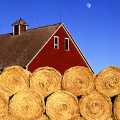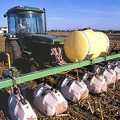|
By Jackie Alan Giuliano, Ph.D.
When despair for the world grows in me
and I wake in the night at the least sound
in fear of what my life and my children's lives may be,
I go and lie down where the wood drake
rests in his beauty on the water, and the great heron feeds.
I come into the peace of wild things
who do not tax their lives with forethought
of grief. I come into the presence of still water.
And I feel above me the day-blind stars
waiting with their light. For a time
I rest in the grace of the world, and am free.
-- Wendell Berry
Farmers in Klamath Falls, Oregon have been protesting the U.S. Bureau of Reclamation's decision to allocate almost all the water in the Klamath Basin Project to protect the endangered or threatened fish Upper Klamath Lake. The farmers claim that the U.S. government is putting fish before people and that environmentalists have a stranglehold on the nation.
Upon closer examination, this conflict reveals a more serious issue - what do we do about farming practices that are not sustainable and are resulting in environmental destruction and societal dysfunction?
Farming practices that have been adopted since the U.S. encouraged a shift to chemical intensive, corporate owned agribusiness after World War II that is highly wasteful of resources and destructive of ecosystems.

Small farm near Ames, Iowa (Photo by Scott Bauer courtesy U.S. Dept. Agriculture)
Farming used to be a rather straightforward process that was done in relative harmony with the surrounding environs. For thousands of years, fertile fields produced vegetables and grains that were eaten by humans and animals. The resulting waste products were put into the soil, the land was re-seeded, often with seeds from last season's crop, and the cycle began again.
But beginning in the 20th century, a new pattern emerged, described by Kirkpatrick Sale, in his book, "Human Scale," as "bigness." Bigger became better in nearly every walk of life and farming particularly suffered, as huge yields were demanded from overworked soils.
These increasingly infertile soils are treated with synthetic fertilizers, often byproducts of the chemical and petroleum industries. The fields are then treated with insecticides and herbicides and given large amounts of water to attempt to restore the moisture that the chemicals remove from the soil. The resulting food is then processed heavily, loosing much of its nutritional value in the process, and transported great distances. The resulting waste products from the consumers of these foods and from the farm animals, is not used on the land. Rather, it is flushed away with water, burned into the air, or put into rivers and oceans.
Productivity declines on these acres and Sale describes this new cycle as, "A broken, ... energy intensive, highly exhaustive, and somewhat poisoned loop."
This new pattern of agriculture - now referred to as agribusiness - is not well suited to the rural family farm. Rather, large corporate owned industrialized farms have taken advantage of the new style of chemically dependent American agriculture.

Hooded sprayers operated by field technician Victor Valladares direct herbicide just to areas between rows of grain sorghum (Photo by Jack Dykinga courtesy USDA)
Such large farms, some measuring many thousands of acres, and increased by over 500 percent in the last 50 years while more than three million one family farms have gone out of business.
The environmental and social consequences of this fundamental shift are grave.
During a three week period of time in Missouri, "two corporate hog factories created more environmental degradations in the form of fish kills and dead streams than was created by all of agriculture in the previous decade," said Roger Allison, executive director of the Missouri Rural Crisis Center in his 1998 testimony to the U.S. Department of Agriculture.
From 1940 to 1975, U.S. farm output increased by 90 percent while fertilizer use increased by 900 percent.
Corporate farms make extensive use of fossil fuel burning machines and excessively use high priced energy, contributing to unstable and steadily rising prices.
http://ens-news.com/ens/aug2001/2001L-08-24g.html |
